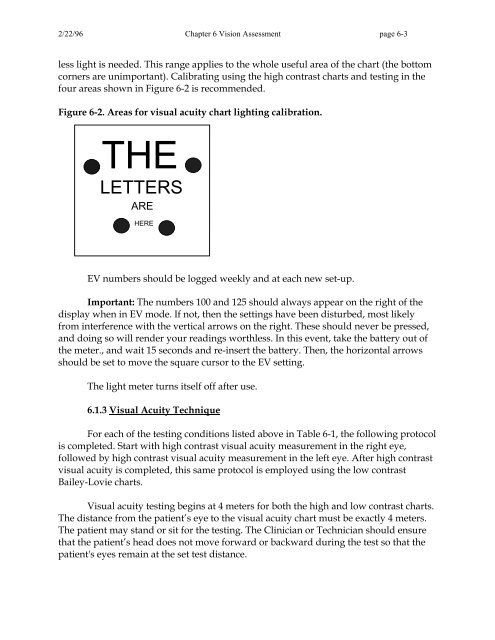OM t of c.iii - Vision Research Coordinating Center - Washington ...
OM t of c.iii - Vision Research Coordinating Center - Washington ...
OM t of c.iii - Vision Research Coordinating Center - Washington ...
Create successful ePaper yourself
Turn your PDF publications into a flip-book with our unique Google optimized e-Paper software.
2/22/96 Chapter 6 <strong>Vision</strong> Assessment page 6-3<br />
less light is needed. This range applies to the whole useful area <strong>of</strong> the chart (the bottom<br />
corners are unimportant). Calibrating using the high contrast charts and testing in the<br />
four areas shown in Figure 6-2 is recommended.<br />
Figure 6-2. Areas for visual acuity chart lighting calibration.<br />
THE<br />
LETTERS<br />
ARE<br />
HERE<br />
EV numbers should be logged weekly and at each new set-up.<br />
Important: The numbers 100 and 125 should always appear on the right <strong>of</strong> the<br />
display when in EV mode. If not, then the settings have been disturbed, most likely<br />
from interference with the vertical arrows on the right. These should never be pressed,<br />
and doing so will render your readings worthless. In this event, take the battery out <strong>of</strong><br />
the meter., and wait 15 seconds and re-insert the battery. Then, the horizontal arrows<br />
should be set to move the square cursor to the EV setting.<br />
The light meter turns itself <strong>of</strong>f after use.<br />
6.1.3 Visual Acuity Technique<br />
For each <strong>of</strong> the testing conditions listed above in Table 6-1, the following protocol<br />
is completed. Start with high contrast visual acuity measurement in the right eye,<br />
followed by high contrast visual acuity measurement in the left eye. After high contrast<br />
visual acuity is completed, this same protocol is employed using the low contrast<br />
Bailey-Lovie charts.<br />
Visual acuity testing begins at 4 meters for both the high and low contrast charts.<br />
The distance from the patient’s eye to the visual acuity chart must be exactly 4 meters.<br />
The patient may stand or sit for the testing. The Clinician or Technician should ensure<br />
that the patient’s head does not move forward or backward during the test so that the<br />
patient's eyes remain at the set test distance.
















